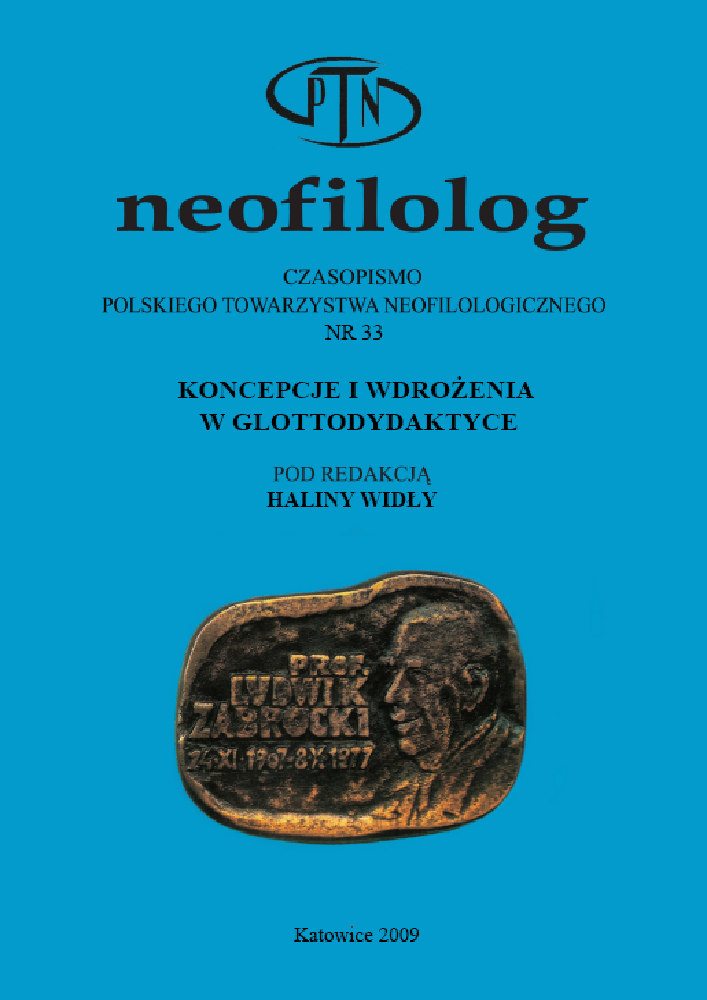Abstract
The aim of the article is to present the function of humour in teaching/learning, paying particular attention to the specific character of foreign language acquisition. The author presents arguments and concisely describes the most common forms of humour occurring in coursebooks . In the second part of the article the author quotes and briefly discusses some examples of comical elements in German textbooks which are intended for children and young people.
References
Podręczniki:
Bęza, S. 2002. Deutsch deine Chance. Poltext.
Bęza, S. 2004. Eine kleine Landeskunde der deutschsprachigen Länder. WSiP.
Grucza, F. 2004. Dein Deutsch. Podręcznik do nauki języka niemieckiego 1 klasa.
Kopp, G., Fröhlich, K. 2004. Tamburin. Hueber.
Krawczyk, E., Kozubska, M., Zastąpiło, L. 2002. Podręcznik do języka niemieckiego dla klasy 1. PWN.
Krawczyk, E., Kozubska, M., Zastąpiło, L. 2005. Podręcznik do języka niemieckiego dla klasy 2. PWN.
Potapowicz, A., Tkaczyk, K. 2009. Aha! Język niemiecki. 1 A, 1B. Kurs dla początkujących. WSiP.
Ptak, M. 2006. Gramatyka niemiecka dla gimnazjum.PWN.
Stasiak, H. 2005. Kängoo Deutsch. REA.
Wybór literatury:
Brzezińska, A. 2004. Jak uczyć się skutecznie języka, czyli jakie prawidłowości z psychologii skutecznego uczenia się i nauczania powinny być uwzględnione w metodach nauczania języków obcych. W: JOwS, 6: 13 – 23.
Burkat, A. 2006. Gry i zabawy jako element wspomagający nauczanie języków obcych. W: JOwS 3: 45 – 48.
Butzkam, W. 2004. Lust zum Lernen. Eine neue Methodik für den Fremdsprachenunterricht. Tübingen und Basel.
Bausch, K., Christ, H. 1995. Handbuch Fremdsprachenunterricht. Tübingen und Basel.
Gorczyca, W. 2002. O interdyscyplinarności glottodydaktyki. W: JOwS, 2: 3 – 15.
Horn, A. 1998. Das Komische im Spiegel der Literatur. Versuch einer systematischen Einführung. Würzburg.
Jastrzębski, J. 1982. Czas relaksu. Wrocław.
Koluch, R. 2003. Gry w nauce języka obcego – zalety i wady. W: JOwS, 1: 43 – 46.
Komorowska, H. 2003. Metodyka nauczania języków obcych. Warszawa.
Kondrad, D. 2004. Jak łatwiej uczyć się języków obcycyh. W: JOwS 6: 5 – 23.
Kucharczyk, R. 2005. Śmiech to zdrowie.... ale i nauka. Wykorzystanie elementów humorystycznych na lekcji języka obcego. W: JOwS 4: 22 – 26.
Krüger, R. 1981. Das Lehrer-Schüler-Verhältnis. W: Pädagogik. Handbuch für Studium und Praxis. München.
Macaire, D., Hosch, W. 2000. Bilder in der Landeskunde. Kassel, München, Tübingen.
Müller-Trinczek, R. 2004. Język niemiecki zabawą w przedszkolu. W: JOwS 4: 83 – 85.
Pradela, J. 2003. „Śpiewać każdy może…” – rola piosenek w nauczaniu języka obcego. W: JOwS 4: 35 – 38.
Pypłacz, K. 2004. Nauczanie języka angielskiego przez gry i zabawy. W: JOwS 6: 188 – 193.
Sakwerda, M., Szymaniak, W. 1998. Komiks? Dlaczego nie? Propozycje wykorzystania komiksu w klasie i w samodzielnej pracdy nad językiem. W: JOwS, 3: 195 – 200.
Storch, G. 1999. Deutsch als Fremdsprache. Eine Didaktik. Theoretische Grundlagen und praktische Unterrichtsgestaltung. München.
Szałek, M. 2004. Jak motywować uczniów do nauki języka obcego. Poznań.
Szczepaniak, J. 1999. Lachen ist gesund. Zur Applizierbarkeit der Textsorte Witz im Fremdsprachenunterricht. W: Bilut-Homplewicz, Z. (ed.) Zur Mehrdimensionalität des Tertes. Repräsentationsformen, Kommunikationsbereiche, Handlungsfunktionen. Rzeszów, 209 – 224.
Szwajgier, H. 2005. Kółko języka niemieckiego – dobry sposób na rozwijanie zainteresowań uczniów. W: JOwS 4: 100 – 103.
Wawrzyniak, Z. 1999. Humor muss sein. Zur Textkomik aus lingustischer Sicht. W: Bilut-Homplewicz, Z. (ed.) Zur Mehrdimensionalität des Tertes. Repräsentationsformen, Kommunikationsbereiche, Handlungsfunktionen. Rzeszów, 237 – 245.
Wolf, N. 1986. Die Bedeutung des Humors für das ästhetisch-sittliche Bewusstsein des Erziehers. Weinheim.
www.muco.at/documents Katsching, Tamara: Angst und Humor bei Grundschullehrer/innen. DW: 17.08.09.
www.sembs.s.bw.schule.de Humor im Unterricht. 1 Teil – Theoretische Grundlagen. DW: 03.07.09.
License
Copyright (c) 1970 Iwona Wowro

This work is licensed under a Creative Commons Attribution-NoDerivatives 4.0 International License.
Authors
Authors of texts accepted for publication in Neofilolog are required to complete, sign and return to the Editorial team’s office the Agreement for granting a royalty-free license to works with a commitment to grant a CC sub-license.
Under the agreement, the authors of the texts published in Neofilolog grant Adam Mickiewicz University in Poznań a non-exclusive, royalty-free license and authorize the use of Attribution-NoDerivatives 4.0 International (CC BY-ND 4.0) Creative Commons sub-license.
The authors retain the right to the free disposal of the work.
Users
Interested Internet users are entitled to use works that have been published in Neofilolog since 2017, under the following conditions:
▪ attribution – obligation to provide, together with the distributed work, information about the authorship, title, source (link to the original work, DOI) and the license itself.
▪ no derivatives – the work must be preserved in its original form. Without the author's consent, it is not possible to distribute the modified work in the form of translations, publications, etc.
Copyrights are reserved for all texts published since 2017.
Miscellaneous
Adam Mickiewicz University in Poznań retains the property right as a whole (layout, graphic form, title, cover design, logo etc.).
